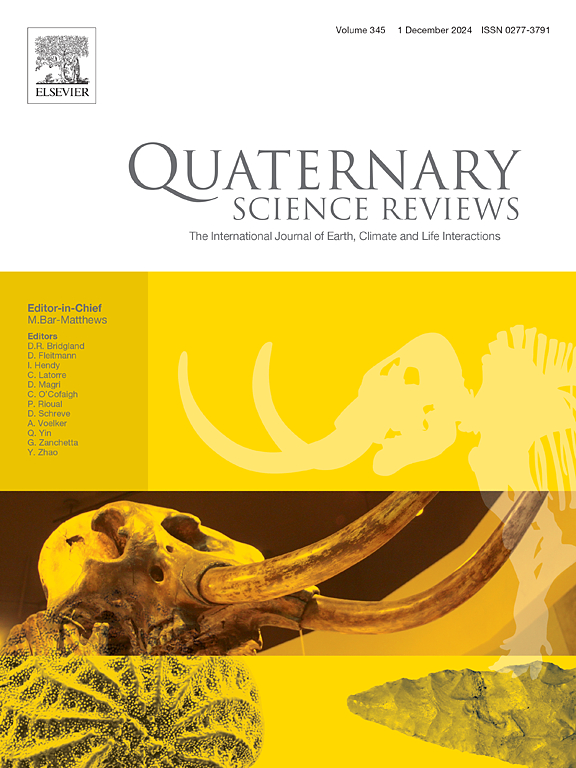Isotopic composition and growth rate of microbialites in Laguna Turquesa, a high-altitude lake in the Central Andes
IF 3.3
1区 地球科学
Q1 GEOGRAPHY, PHYSICAL
引用次数: 0
Abstract
This study investigates the isotopic characterization of microbialites from Turquesa Lake located in the arid, high-altitude region of the Central Andes (3752 m.a.s.l.). Stable isotope analyses (δ13C and δ18O) were conducted on three microbialite levels (M1, M2, and M3), with complementary radiocarbon dating revealing ages of 11,830 ± 170 years BP for the outer layer of M1 and 13,140 ± 120 years BP for its core. Findings indicate variable microbial growth rates, peaking in the core (0.12 mm/year) and decreasing towards the outer layers (0.027 mm/year), with internal structures reflecting reticulate intervals in central zones and laminated patterns in outer layers. δ13C values ranged from 11.86 to 9.93 ‰ and δ18O from 10.60 to 6.22 ‰. The results suggest that M1 and M2 formed when Turquesa and Peinado lakes were connected, displaying complex isotopic fractionation influenced by evaporation and photosynthesis, while M3 formed under evaporative conditions associated with the separation of the lakes due to evaporation. Nevertheless, M3 appears to be less evaporative than M1 and M2, as indicated by its lower δ18O values. This research provides new insights into how extreme environmental conditions in the Puna have influenced the isotopic evolution and formation of microbialites.
安第斯山脉中部高海拔湖泊图尔克萨湖微生物岩的同位素组成和生长速率
本文研究了位于安第斯山脉中部干旱高海拔地区(3752 m.a.s.l.)的Turquesa湖微生物岩的同位素特征。对3个微生物岩(M1、M2和M3)进行了稳定同位素分析(δ13C和δ18O),并进行了补充放射性碳定年,结果显示M1的外层年龄为11830±170年BP,核心年龄为13140±120年BP。研究结果表明,微生物生长速率变化较大,在岩心达到峰值(0.12 mm/年),向外层逐渐降低(0.027 mm/年),内部结构反映出中心区的网状间隔和外层的层状模式。δ13C值为11.86 ~ 9.93‰,δ18O值为10.60 ~ 6.22‰。结果表明,M1和M2形成于Turquesa湖和Peinado湖连接时,受蒸发和光合作用的影响,表现出复杂的同位素分馏;M3形成于蒸发条件下,由于蒸发作用,湖泊分离。然而,M3的蒸发量似乎比M1和M2少,其δ18O值较低。这项研究为普纳的极端环境条件如何影响微生物岩的同位素演化和形成提供了新的见解。
本文章由计算机程序翻译,如有差异,请以英文原文为准。
求助全文
约1分钟内获得全文
求助全文
来源期刊

Quaternary Science Reviews
地学-地球科学综合
CiteScore
7.50
自引率
15.00%
发文量
388
审稿时长
3 months
期刊介绍:
Quaternary Science Reviews caters for all aspects of Quaternary science, and includes, for example, geology, geomorphology, geography, archaeology, soil science, palaeobotany, palaeontology, palaeoclimatology and the full range of applicable dating methods. The dividing line between what constitutes the review paper and one which contains new original data is not easy to establish, so QSR also publishes papers with new data especially if these perform a review function. All the Quaternary sciences are changing rapidly and subject to re-evaluation as the pace of discovery quickens; thus the diverse but comprehensive role of Quaternary Science Reviews keeps readers abreast of the wider issues relating to new developments in the field.
 求助内容:
求助内容: 应助结果提醒方式:
应助结果提醒方式:


